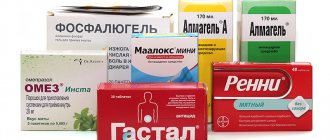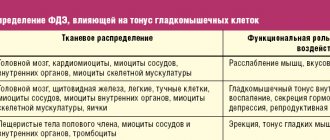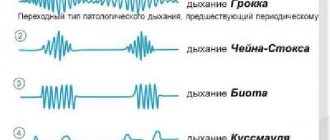Bronchospasm is an acute condition in which the peribronchial muscles contract, which causes a decrease in the lumens. Bronchospasm leads to an almost complete cessation of the removal of carbon dioxide from the body and a serious decrease in the volume of incoming oxygen. As a rule, it is very difficult for a patient to exhale, for which he has to make an effort; inhaling is also more difficult for him than for a healthy person, although less effort is made than for exhalation. With the help of a stethoscope, you can clearly hear exhalation sounds.
Bronchospasm is a very dangerous condition that requires immediate medical attention. People who are prone to it are strictly recommended to carry medications that can interrupt attacks. Medicines should be used only those prescribed by a doctor - self-medication of bronchospasms is life-threatening.
Causes/factors of bronchospasm
Bronchospasm can be a consequence of both illness and an allergic reaction to irritants, the result of intoxication and some other reasons. In general, the main causes and factors influencing the manifestation of the disease are as follows:
- bronchitis, bronchial asthma, exacerbation of obstructive chronic pulmonary disease;
- allergic reactions (anaphylaxis) to tobacco smoke, chemicals, dust or other substances;
- stress or increased physical activity (especially in patients with asthma);
- foreign bodies in the bronchi;
- side effects of drugs.
Asthma attack
Attacks of suffocation during bronchial asthma: first aid
At the beginning of the disease, people may not even be aware of the upcoming attack.
Children, while experiencing it, experience enormous stress. Therefore, it is so important to know how to properly provide first aid during an attack of suffocation. Bronchial asthma leads to panic, which only aggravates the situation. If a person has an attack in front of your eyes, then you need to make sure that he does not have medications with him that help relieve asthma. Medicines are selected for each patient individually by the attending physician, depending on the patient’s sensitivity, the frequency of suffocation, and the form of the disease. The drugs can be in the form of tablets or pocket-type inhalers. The most commonly used are the latter agents, which are injected directly into the bronchi. They relieve spasms within a few minutes.
During an attack, the patient must sit, and his hands should rest on the table or back of a chair. Loosen his tie or unbutton the tight collar of his shirt. If possible, open windows to allow oxygen to enter. It is recommended to immerse a person’s feet in a container of hot water up to the shins.
In case of a repeated attack that lasts more than fifteen minutes, it is necessary to call an ambulance or bring the patient to the hospital yourself.
How to relieve an asthma attack?
If choking occurs, doctors recommend not delaying the use of medications. However, how to relieve an asthma attack when the patient does not have any medical supplies with him? Before the ambulance arrives, you can alleviate the person’s condition. Try to calm him down and normalize his breathing. To do this, you can take any antihistamine. These anti-allergy drugs are especially effective at the very beginning of an attack. Mustard plasters placed on the chest will also make breathing easier during severe spasms.
Prevention of asthma attacks in bronchial asthma
Quitting smoking and alcohol, regular exercise will strengthen the immune system and reduce the number of attacks. Prevention of suffocation in bronchial asthma includes:
- Massage of the sternum and intercostal area;
- Adding honey and propolis to the diet;
- Regular intake of activated birch charcoal;
- Perform inhalations before bedtime.
Another effective method of preventing attacks is cupping massage. It can be done even at home. The procedure lasts on average no more than 10 minutes. To perform a massage you will need:
- Petrolatum;
- Cotton swab;
- Matches;
- Medical jar;
- Alcohol.
The patient's back should be generously lubricated with Vaseline. The swab should be moistened with alcohol and set on fire. Place it in the jar for a few seconds. Remove the tampon. Quickly apply the can to your back and move it up and down.
Bronchodilators in the treatment of respiratory diseases
In the structure of respiratory diseases, chronic obstructive pulmonary disease (COPD) and bronchial asthma (BA) are the leading causes of morbidity and mortality.
The pathophysiological basis of both nosological forms is bronchial obstruction, the relief or correction of which requires bronchodilator therapy. This provision is enshrined in international and national guidelines for the diagnosis and treatment of BA and COPD [1–6].
It should be noted that asthma and COPD are two independent diseases that have different etiologies, pathogenesis, prognosis, and also require different approaches to treatment. Thus, in particular, ventilation disorders in asthma are characterized by reversible bronchial obstruction and bronchial hyperreactivity, which makes it advisable to use bronchodilators used in this disease. On the contrary, bronchial obstruction in COPD steadily progresses and is only partially reversible. The latter circumstance argues for the feasibility of the clinical use of bronchodilators in this disease.
Naturally, these differences between asthma and COPD require a differentiated approach to both the selection of specific bronchodilators and the tactics of their administration. Thus, if patients with COPD are prescribed bronchodilators mainly on an ongoing basis, then patients with asthma are prescribed more often “on demand” and/or in combination with basic anti-inflammatory therapy (glucocorticosteroids or cromones).
Modern bronchodilators can be divided into three groups, listed below in the order in which they were introduced into clinical practice.
- Anticholinergic (cholinolytic) drugs. By duration of action: short-acting (ipratropium bromide, oxitropium bromide) and long-acting (tiotropium bromide); by route of administration: inhalation only.
- Methylxanthines. By duration of action: short-acting (aminophylline, diaphylline, aminophylline) and long-acting (teopek, theotard, etc.); by route of administration: mainly injection forms - intravenously, intramuscularly (aminophylline, diaphylline) and tablet forms, prolonged theophyllines (micronized forms).
- β2-agonists. By duration of action: short-acting (fenoterol, salbutamol, terbutaline) and long-acting (salbutamol, formoterol); by route of administration: inhalation (short-acting and long-acting β2-agonists), parenteral injection forms, oral tablet forms.
Anticholinergic drugs. For many millennia, traditional medicine has been used to treat respiratory diseases. References to the use of plants of the nightshade family were found in ancient Egyptian papyri. Hippocrates recommended that people with lung diseases use incense and smoke powders prepared from the dried roots and leaves of belladonna (Atropa belladonna), datura (Datura stramonium), and henbane (Hyoscyamus niger). Recent studies have found that the effect of smoking anti-asthmatic cigarettes containing Datura stramonium leaves is comparable to that of modern bronchodilators [7].
By the beginning of the 19th century. The anticholinergic effect of belladonna alkaloids was already known; a little later, scientists established the role of the parasympathetic nervous system in the development of bronchospasm, and since the mid-19th century, cholinergic blockers - atropine and platyphylline, soon synthesized - have become the “gold standard” in the treatment of asthma. The widespread use of anticholinergics for this indication continued until the 70s. XX century Only with the advent of powerful selective β2-agonists, as well as methylxanthines, atropine lost its importance in the treatment of patients with asthma. This was greatly facilitated by the presence of a large number of adverse events accompanying the administration of the drug: dry mouth, impaired mucociliary clearance, mydriasis, etc. [8].
In the 70s XX century Muscarinic receptors in the human respiratory tract were isolated and classified (M1-, M2-, M3 receptors). The establishment of the important role of the parasympathetic nervous system in the control of bronchial patency in asthma gave impetus to further development of anticholinergic drugs, which led to the creation of a fundamentally new drug - ipratropium bromide [8, 9]. However, during clinical trials in patients with asthma, its effectiveness turned out to be low. On the contrary, the drug demonstrated a clear clinical and, in some cases, bronchodilator effect in patients with COPD. Thus, it was possible to prove the partial reversibility of bronchial obstruction in COPD and subsequently establish its two pathophysiological components - reversible and irreversible.
The reversible (“bronchodilator”) component of bronchial obstruction is represented by inflammatory swelling of the mucous membrane of the respiratory tract, accumulation of inflammatory cells, mucus and plasma in the bronchial lumen, spasm of smooth muscles, which are mainly controlled by the parasympathetic part of the autonomic nervous system, the tone of which is naturally increased in COPD [10] .
The irreversible (“emphysematous”) component of bronchial obstruction is caused by the development and progression of pulmonary emphysema and the so-called disease of the small bronchi (decreased elastic traction of the lung tissue due to uneven, predominantly centriacinar emphysema, early expiratory collapse, deformation and narrowing of the small bronchi). It was assumed that these structural changes cannot serve as a point of application for bronchodilators and/or anti-inflammatory drugs. However, later it was possible to establish that it is these changes in the lung parenchyma that cause the formation of hyperinflation of the lungs with the development of an “air trap”, leading to impaired emptying of the alveoli during exhalation (this pathophysiological phenomenon can be most clearly demonstrated when performing physical activity). It is this mechanism that explains the development of such cardiac symptoms of COPD as severe shortness of breath and decreased exercise tolerance, which significantly worsen the quality of life of this category of patients [11].
The most well-known and widely used inhaled anticholinergic drug is currently ipratropium bromide. The drug is well tolerated, effective and safe with long-term use, does not cause the development of tachyphylaxis, and has no cardiotoxic effects. It is important to note that the sensitivity of M-cholinergic receptors does not decrease with age. That is why, in recommendations for the management of patients with COPD, approaches to prescribing this drug are defined as follows: treat “as long as the symptoms of the disease continue to cause inconvenience to the patient” [2].
The duration of action of ipratropium bromide is 4–6 hours, resulting in the need for repeated inhalations (4 times a day), so it is sometimes problematic to control possible deterioration of bronchial obstruction at night or in the early morning hours. Like atropine, ipratropium bromide is not a selective anticholinergic blocker and equally quickly blocks all three types of muscarinic receptors, so the patient should be closely monitored, since blockade of M2 receptors can sometimes lead to paradoxical bronchoconstriction [9].
A representative of the new generation of anticholinergic drugs is tiotropium bromide, registered in Russia in 2003. The peculiarities of the chemical structure of the drug explain the uniqueness of its interaction with muscarinic receptors, namely the unique kinetic selectivity, i.e., differences in the rate of blocking of the corresponding subtypes of muscarinic receptors, as well as increasing the duration of action [12, 13].
In the course of the studies, in particular, it was shown that long-term bronchodilation (~ 24 hours), recorded after a single inhalation of tiotropium bromide, persists even with long-term use (for 12 months) [14, 15]. Already 30 minutes after the first inhalation, the values of forced expiratory volume in the first second (FEV1) and forced vital capacity (FVC) increased, and did not subsequently decrease over the next 24 hours. The greatest bronchodilator effect was observed by the second week of treatment with tiotropium bromide.
Long-term therapy with tiotropium bromide (for 12 months) is accompanied by optimization of bronchial obstruction, regression of respiratory symptoms, and improvement in the quality of life of patients [16]. At the same time, the severity of shortness of breath clearly decreased. The famous pulmonologist P. Jones highly appreciated the possibilities of symptomatic control using inhaled tiotropium bromide, noting its sanogenetic effect: patients who took the drug for a long time no longer experienced shortness of breath during exercise and moved at a pace characteristic of their age [17]. Regression of shortness of breath is explained by a decrease in lung hyperinflation and the size of the “air trap”. Moreover, in the long-term treatment of patients with COPD, it was possible to demonstrate the therapeutic superiority of tiotropium bromide over ipratropium bromide [18].
An important advantage of inhaled anticholinergic drugs is the minimal frequency and severity of adverse events. The most common of these is dry mouth, which, as a rule, does not lead to discontinuation of medications [16, 18].
Methylxanthines. For many decades, methylxanthines (theophylline, etc.) have been used in the treatment of patients with asthma, although the mechanism of their action remained unclear for a long time. In 1859, Dr. Hyde Salter reported that a cup of strong coffee could stop an attack of asthma. In 1888, theophylline was isolated from tea leaves. For a long time, the approach to the use of theophylline was purely empirical and only after the mechanism of its action was clarified in the late 1930s. the drug became widespread. The bronchodilator effect of theophylline occurs through inhibition of phosphodiesterase isoforms with a subsequent increase in intracellular cAMP content and relaxation of smooth muscles of the respiratory tract. In addition, the immunomodulatory and anti-inflammatory effects of theophylline have been established, which allows this drug to be prescribed as monotherapy when it is impossible to use inhaled anti-inflammatory and/or bronchodilator drugs. Short-term use of long-acting theophyllines for 6–12 weeks is accompanied by improved indicators of symptomatic control of the disease and an increase in FEV1 [19, 20].
When discussing the possibilities of using theophylline in patients with broncho-obstructive diseases, it is important to take into account its extrapulmonary effects: improvement of peripheral ventilation, reduction of the development of “air traps”, improvement of diaphragm function, especially with hyperinflation of the lung, improvement (restoration) of mucociliary clearance, dilatation of the arteries of the pulmonary circulation, decreased pressure in the pulmonary artery and hemodynamic “unloading” of the right heart, increased physical performance.
At the same time, it is known that the metabolism of theophylline is subject to significant changes. Thus, in smokers, people suffering from chronic alcoholism, patients taking rifampicin or anticonvulsants, theophylline clearance is accelerated, which means that when using a standard dosage regimen, the plasma concentration of the drug may not reach therapeutic levels. On the contrary, with age, in the presence of arterial hypoxemia (PaO2 < 45 mm Hg), respiratory acidosis, in patients with congestive heart failure, liver cirrhosis, carrying a viral infection, taking macrolides (primarily clarithromycin and erythromycin), fluoroquinolones, cimetidine (but not ranitidine), there is a slowdown in the clearance of theophylline, which means that even with a standard dosage regimen there is a risk of creating toxic concentrations of the drug in the blood plasma.
However, the predictability of effects on the plasma concentration of theophylline makes it possible to either avoid them or change the dose (while monitoring the concentration of the drug in the blood). It has also been shown that when theophylline and salmeterol are used together, the “sum” of adverse events is comparable to the frequency of adverse events with monotherapy with each of these drugs [20].
The second no less serious circumstance limiting the widespread use of theophylline is its small therapeutic breadth, which requires determining the concentration of the drug in the blood plasma. It has been established that the optimal concentration of theophylline in blood plasma is 8–15 mg/l. An increase in concentration to 16–20 mg/l is accompanied by a more pronounced bronchodilator effect, but at the same time it is fraught with the development of a large number of adverse events, especially in patients of older age groups [21]. Meanwhile, recent studies have shown that the anti-inflammatory effect of theophylline is more pronounced when low concentrations of the drug are reached (5–10 mg/l) [22].
Currently, theophylline is usually classified as a second-line drug (in relation to anticholinergic blockers and β2-agonists). They represent a kind of reserve for those patients in whom other areas of bronchodilator therapy do not adequately control the symptoms of the disease. It is also possible to prescribe theophylline to those patients who cannot use inhaled delivery devices.
β2-agonists. Currently, it is difficult to imagine therapy for BA and COPD without β2-agonists. However, the history of the use of β-adrenergic receptor stimulants goes back a little over 100 years.
The basis for the first injection of adrenaline (epinephrine) to a patient with asthma was its vasoconstrictor effect, since it was assumed that bronchial obstruction was based on swelling of the mucous membrane of the respiratory tract. Subsequently, adrenaline was widely used to relieve attacks of bronchial obstruction, both parenterally and inhaled. The short duration of action (up to 1–1.5 hours), a large number of undesirable effects of adrenaline, as a non-selective stimulator of α- and β-adrenergic receptors, prompted scientists to search for new drugs [24].
One of them was isoproterenol, synthesized in 1940, a non-selective β-agonist. It was successfully used in inhalation form, allowing patients suffering from asthma to move freely - first with a glass nebulizer, and then (since 1956) with a metered dose aerosol inhaler. Unfortunately, the duration of action of isoproterenol also did not exceed 1.5–2 hours, and frequent inhalations of the drug contributed to the development of adverse events, in particular life-threatening cardiac arrhythmias.
Subsequent studies of the pharmacological properties of isoproterenol revealed the presence of two subtypes of β-adrenergic receptors: β1- and β2-adrenergic receptors, which made it possible to synthesize the first selective β2-agonist salbutamol soon (1970), and a little later - fenoterol and terbutaline [24] .
β2-agonists cause bronchodilation, this occurs primarily as a result of direct stimulation of β2-adrenergic receptors on airway smooth muscle. They are considered as functional antagonists, causing the reverse development of bronchospasm, regardless of the constrictor effect that has taken place. This property of the drugs is especially important since many proinflammatory mediators have a bronchoconstrictor effect.
β2-agonists are characterized by a rapid onset of bronchodilation (within 5 minutes) and a sufficient duration of action (up to 5–6 hours). However, they continue to be short-acting drugs and require repeated inhalations (usually 4 times a day). The drugs are used primarily by inhalation, although there are other dosage forms - injectable, intended to relieve severe exacerbation of asthma, and oral, to prevent/relieve nocturnal attacks of asthma.
In 1990, the first long-acting, highly selective β2-agonist salmeterol was synthesized, and a little later, formoterol. The duration of action of the drugs reached 12 hours, which made it possible to use them 2 times a day and reliably prevent night/pre-dawn attacks of asthma. Despite the same duration of action, there is a difference between these drugs in the timing of the onset of the bronchodilator effect. If salmeterol begins to act within 30–40 minutes, then formoterol is able to stop an attack of bronchial obstruction within 5 minutes after inhalation, similar to short-acting β2-agonists. Numerous studies evaluating the effectiveness of long-acting β2-agonists have shown that these drugs help reduce the frequency of asthma exacerbations, the number of hospitalizations, and also reduce the need for inhaled glucocorticosteroids (ICS) [3].
The long duration of action of salmeterol and formoterol makes it possible to prevent nocturnal attacks of bronchial obstruction. At the same time, monotherapy with long-acting β2-agonists is recommended only for the treatment of COPD [1, 2, 4]. Recent studies have shown that salmeterol and formoterol, like tiotropium bromide, can influence the size of the “air trap”, thereby increasing the exercise tolerance of COPD patients [25].
A study comparing the effectiveness of tiotropium bromide and formoterol [26] showed that tiotropium bromide is more effective on daytime symptoms of COPD, while formoterol improves pulmonary function parameters at night. This fact also indicates that in some cases it is advisable to combine long-acting anticholinergics and β2-agonists.
In the treatment of asthma, long-acting β2-agonists can only be used in combination with ICS [3]. This is also facilitated by the fact that the addition of long-acting β2-agonists is equivalent to doubling the dose of ICS. As a result of the use of a combination of ICS and long-acting β2-agonists, it was possible to reduce the incidence of adverse events that often develop during anti-inflammatory therapy with ICS. This fact gave rise to the creation of such combination drugs as seretide (a combination of salmeterol and fluticasone) and Symbicort turbuhaler (a combination of formoterol and budesonide). These drugs should be used in the treatment of asthma, but their short-term use in the treatment of COPD is also possible [1–5].
It should be noted that β2-agonists, both short-acting and long-acting, are not free from the development of adverse events. Frequent use of short-acting β2-agonists during the day (more than 4-5 times) and/or monotherapy with long-acting β2-agonists in asthma can mask progressive inflammation of the airways, which in the absence of ICS can cause the development of severe exacerbation of asthma.
Particular attention should be paid when prescribing β2-agonists to elderly patients suffering from concomitant diseases of the cardiovascular system. Firstly, with age, the number and sensitivity of β2-adrenergic receptors in the respiratory tract decrease, which causes a decrease in the therapeutic effectiveness of drugs. Secondly, the prescription of even therapeutic doses can aggravate hypokalemia, which naturally develops in the majority of elderly and old people, which, in turn, can lead to the development of severe, often life-threatening cardiac arrhythmias.
Combined bronchodilator therapy. The combination of an inhaled β2-agonist (short-acting or long-acting) and an anticholinergic blocker is accompanied by an improvement in bronchial obstruction to a greater extent than when prescribing either of these drugs as monotherapy [27]. It is possible to optimize the ventilation function of the lungs to an even greater extent with the simultaneous use of β2-agonists, anticholinergic blockers and theophylline [28]. However, according to popular belief, combination therapy should be used only if it is impossible to achieve an optimal therapeutic effect with any one class of bronchodilators.
In accordance with modern recommendations for the management of patients with COPD, in cases of inadequate control of the disease, combination therapy should be used, for example, Berodual (ipratropium bromide + fenoterol). The use of combination drugs promotes better compliance and significantly reduces the cost of treatment compared to the use of each drug separately.
BA is a disease based on inflammation of the airways, accompanied by reversible bronchial obstruction and changes in the sensitivity of the bronchi and manifested by an attack of suffocation, status asthmaticus, or in the absence of such symptoms of respiratory discomfort (paroxysmal cough, distant wheezing and shortness of breath) against the background of a hereditary predisposition to allergic diseases , extrapulmonary signs of allergy, blood and/or sputum eosinophilia.
The use of bronchodilators in patients with asthma due to the presence of transient bronchial obstruction is certainly justified. However, at present, when the leading role of inflammation in the pathogenesis of asthma is recognized, it is advisable to use anti-inflammatory drugs, and primarily ICS, as a basic therapy for the disease. Monotherapy with β2-agonists, as already noted, can mask progressive inflammation and contribute to the development of severe exacerbations of asthma.
According to the modern concept of stepwise therapy for BA, short-acting β2-agonists should be used as monotherapy only in patients with rare attacks (mild intermittent BA that does not require anti-inflammatory therapy) (see Fig. 1, under the heading “Under glass”). It is necessary to pay attention to the fact that if a β2-agonist is taken more than 4 times a day, both to relieve an attack and to prevent it, it is necessary to prescribe anti-inflammatory therapy corresponding to the next stage of treatment.
At stages II, III and IV, the use of short-acting β2-agonists should also not exceed 4 times a day. Thus, the frequency of administration
Short-acting β2-agonists are a marker of control over the symptoms of the disease, i.e., the adequacy of anti-inflammatory therapy.
Long-acting β2-agonists can be used already at the second stage of treatment, especially in patients with nocturnal or early morning asthma attacks/episodes of respiratory discomfort. It is natural to prescribe long-acting drugs at stages III and IV - in order to potentiate the effect of ICS and possibly reduce the dose of the latter.
As for anticholinergics, the role of tiotropium bromide in the treatment of asthma has not yet been determined. Ipratropium bromide, being inferior in the severity of the bronchodilator effect to β2-agonists, can be added to the complex therapy of severe asthma (IV stage) and/or used to relieve a severe asthmatic attack.
COPD is a disease characterized by chronic bronchial obstruction, which is only partially reversible and slowly progresses over the years. Bronchial obstruction naturally leads to the development of shortness of breath during physical activity, an increasing decrease in tolerance to physical activity - all this limits the activity of patients and leads to a sharp decrease in their quality of life [1, 2, 3].
The cornerstone in the treatment of patients with COPD is therapy aimed at reducing bronchial obstruction. For this purpose, short- and long-acting β2-agonists, anticholinergic drugs, and methylxanthines are used [1–6].
When prescribing bronchodilators to patients with COPD, every doctor must answer two key questions: which bronchodilator to choose and how to use the bronchodilator - “on demand” or on a regular basis?
It should be noted that the issues of choosing bronchodilators are not fully defined and are controversial. This is primarily due to the fact that both β2-agonists and anticholinergic drugs are almost equally effective in COPD: they reduce shortness of breath and improve quality of life. Thus, experts from the European Respiratory Society (ERS) recommend either β2-agonists or anticholinergic drugs, without providing clear criteria for choosing between them [6]. On the contrary, the recommendations of the American Thoracic Society (ATS) [6] and the French Pulmonary Society give preference to anticholinergic drugs (as the drugs of choice in patients with persistent symptoms), while β2-agonists are proposed to be used “on demand” in patients with paroxysmal shortness of breath [3 , 4]. Finally, according to experts from the British Thoracic Society (BTS), β2-agonists should be prescribed initially, and anticholinergic drugs should only be used if sympathomimetics are insufficiently effective or if there is a need to “intensify” bronchodilator therapy [5].
It should be noted that anticholinergics are still preferable for the regular treatment of COPD than β2-agonists. This is explained primarily by the fact that the reversible component of bronchial obstruction is controlled by the parasympathetic division of the autonomic nervous system.
In addition, patients with COPD are, as a rule, elderly and senile people, in whom β2-agonists can naturally cause undesirable effects, and the sensitivity of muscarinic receptors remains until old age.
At the same time, short-acting β2-agonists, characterized by an unsurpassed speed of onset of bronchodilator effect, are most suitable for on-demand therapy. If β2-agonists are poorly tolerated or in order to increase the power of the bronchodilator effect to relieve attacks, it is possible to use combination drugs (Berodual). The dose of β2-agonist in this drug is half that of standard inhalers; in this case, the combination of two drugs potentiates the effect of each other.
As for methylxanthines, as already mentioned, they are “second-line” drugs and are prescribed either for intolerance to inhaled drugs for one reason or another, or as an additive drug when β2-agonists, anticholinergics, or their combination are ineffective.
The preference for prescribing one or another bronchodilator is determined after an inhalation test, and the final decision remains with the patient.
In accordance with modern recommendations, the tactics of bronchodilator therapy for patients with COPD can be presented as follows (see Fig. 2, under the heading “Under glass”).
Stage I (mild) COPD involves the prescription of short-acting bronchodilators on demand. At stage II (moderate course), long-acting bronchodilators—tiotropium bromide or β2-agonists—are added to therapy, with the former being preferable (left side of the regimen), while the prescription of long-acting β2-agonists (right side of the regimen) is alternative. At stage III (severe course), it is advisable to combine one of the long-acting β2-agonists and tiotropium bromide. Stage IV is characterized as extremely severe: the course of the disease with frequent exacerbations - and involves, in addition to bronchodilator therapy, the administration of glucocorticosteroids (inhaled and/or oral).
Literature
- Chronic obstructive pulmonary disease: A practical guide for doctors. Federal program. M., 2004.
- Global Initiative for Chronic Obstructive Lung Disease. Global Strategy for Diagnosis, Management, and Prevention of Chronic Obstructive Pulmonary Disease. (Based on the April 1998 NHLBI/WHO Workshop). National Institutes of Healt, National Heart. Lung and Blood Institute. April 2001 (Updated 2003).
- Global Strategy for Asthma Management and Prevention. National Institutes of Health, National Heart, Lung, and Blood Institute REVISED 2002 Updated from: NHLBI/WHO Workshop Report: Global Strategy for Asthma Management and Prevention Issued January, 1995. NIH Publication. No. 2.
- Chronic Obstructive Pulmonary Disease. National clinical guideline on management of chronic obstructive pulmonary disease in adults in primary and secondary care. Thorax. 2004; 59; 1.
- British Guideline on the Management of Asthma. Thorax. 2003; 58; 1.
- Celli BR, McNee W. Standards for the diagnosis and treatment of patients with COPD: a summary of the ATS/ERS position paper. Eur Respir J. 2004; 23: 932-936.
- Trechsel K., Bachofen H., Scherre M. Die bronchodilatorische Wirkung der Asthmazigarette. Scweizerische Medizinische Wochenschrift 1973; 103:415-423.
- Gross NJ editor. Anticholinergic therapy in obstructive airway disease. London, Franklin Scientific Publications, 1993.
- Barnes PJ Muscarinic receptor subtypes in airways. Life Sci. 1993; 52:521-527.
- Barnes P. Tiotropium bromide: a new long-acting anticholinergic bronchodilator. In: Barnes P., Buist AS editors. The role of anticholinergics in chronic obstructive pulmonary disease and chronic asthma. Macclesfied Cheshire, UK: Gardiner-Caldwell Communications Limited; 1997; 126-136.
- Calverley HVA Breathlessness during exercise in COPD: how do the drugs work? Thorax. 2004; 59: 45-457.
- Barnes PJ The pharmacological properties of tiotropium. Chest. 2000; 117: 63-69.
- Disse B., Reichl R., Speck G. et al. DF 679 BR, a novel long acting anticholinergic bronchodilator. Life Sci 1993; 52(5-6): 537-544.
- van Noord JA, Bantje TA, Eland ME et al. A randomized controlled comparison of tiotropium and ipratropium in the treatment of chronic obstructive pulmonary disease. The Dutch Tiotropium Study Group. Thorax. 2000; 55: 289-294.
- O`Donnell DE, Fluge F., Gerken F. et al. Effects of tiotropium on lung hyperinflation, dyspnoea and exercise tolerance in COPD/ Eur Respir J/ 2004; 23: 832-840.
- Casaburi R., Mahler DA, Jones PW et al. A long-term evaluation of once-daily inhaled tiotropium in chronic obstructive pulmonary disease. Eur Respir J. 2002; 19: 217-224.
- P. Personal communication. 10th European Respiratory Society Annual Conference (ERS), Florence, Italy, 30 August-3 September 2000. www.medscape.com/ConferenceSearchAll.ctm/.
- Wincken W., van Noord JA, Greefhorst APM et al. on behalf of the Dutch/Belgian Tiotropium Study Group. Improved health patients with COPD during 1-yr's treatment with tiotropium. Eur Respir J. 2002; 19: 209-216.
- Murciano D. et al. A randomized, controlled trial of theophylline in patients with severe chronic obstructive pulmonary disease. N Engl J Med. 1989; 320: 1521-1525.
- ZuWallak RL, Mahler DA, Reilly D. et al. Salmeterol Plus Theophilline Therapy in the Treatment of COPD. Chest. 2001; 119: 1661-1670.
- Shannon M. Life-threatening events after theophylline overdose: a 10-year-prospective analysis. Arch Intern Med. 1999; 159:989-994.
- Torphy TJ State of the art: Phosphodiesterase isozymes: Molecular targets for novel antiasthma agents. Am J Respir Crit Care Med. 1998; 157: 351-370.
- Tsukino M. et al. Effects of theophylline and ipratropium bromide on exercise performance pulmonary disease. Thorax. 1998; 53: 269-273.
- Lawrence D. R., Benitt P. N. Clinical pharmacology: In 2 vols. M.: Medicine, 1991.
- O`Donnell DE, Voduc N., Fizpatrick M., Webb KA Effect of salmeterol on tye ventilatory response to exercise in chronic obstructive pulmonary disease. Eur Respir J. 2004; 24: 86-94.
- Van Noord JA, Aumann J.-L., Jansens E. et al. Comparison of tiotropium once daily, formoterol twice daily and both combined once daily in patients with COPD. Eur Respir J. 2005; 26: 214-222.
- Van Noord JA et al. Long-term treatment of chronic obstructive pulmonary disease with salmeterol and the additive effect of ipratropium. Eur Respir J. 2000; 15: 878-885.
- Karpel JP et al. A comparison of inhaled ipratropium, oral theophylline plus inhaled beta-agonist, and the combination of all three in patients with COPD. 1994; 105: 1089-1094.
- Tashkin D, Cooper CB The role of long-acting bronchodilators in the management of stable COPD. Chest. 2004; 125: 249-259.
I. L. Klyachkina , Candidate of Medical Sciences, Associate Professor of the State Institute of Internal Medicine of the Ministry of Defense of the Russian Federation, Moscow
Help for elderly people in boarding houses “Longevity” with bronchospasms
Boarding houses for the elderly "Longevity" (private nursing homes) provide assistance to elderly people with various diseases, including diseases of the respiratory system, allergies, asthma and many other problems.
Our employees monitor residents of boarding houses for the elderly around the clock , so the likelihood of a threat to the lives of patients when bronchospasm or other dangerous condition occurs is much lower than when caring for the elderly at home.
The medical staff of boarding houses is always nearby and ready to provide first aid. In addition, the Longevity Medical Center prescribes drug treatment, complex therapy and a number of preventive measures aimed at the general health of older people. Predisposing factors that cause exacerbation of symptoms of the disease are excluded. Treatment is aimed both at eliminating the cause (the underlying disease causing bronchospasm) and at improving the overall quality of life. Proper nutritious nutrition, developed by nutritionists taking into account the needs of an elderly person, a calm environment and clean air, and, if possible, giving up bad habits, all this together has a healing effect on elderly people living in our boarding houses.
Symptoms of bronchospasm
At the very beginning of the attack, patients feel heaviness in the chest and difficulty in exhaling. The veins in the neck dilate, there is a feeling of lack of oxygen, shortness of breath and a feeling of fear.
Actively produced mucus in the bronchi makes breathing even more difficult, blocking the flow of air and causing coughing and wheezing in the lungs.
There is pallor, increased heart rate, flattening of the wings of the nose when inhaling, and blue discoloration of the nasolabial triangle.
At this stage, a person experiences serious breathing difficulties as a result of blockage of the bronchi and requires urgent medical attention to relieve the attack with special medications, otherwise this can lead to serious consequences or even death. If an attack occurs, you must urgently call an ambulance.
How to provide first aid for bronchospasm
Elderly people with a history of bronchospasms, status asthmaticus, and allergic reactions need constant attention from loved ones. Bronchospasms are especially dangerous for older people after strokes, heart attacks, and other diseases of the cardiovascular system. Often, attacks of suffocation cause panic not only in patients, but also in those around them. It is important not to get confused and to perform the following steps in time, even before the ambulance arrives:
- remove tight clothing from the patient;
- exclude exposure to substances that caused the attack (if any);
- ventilate the room well or take the patient out into fresh air;
- give warm mineral water to drink;
- if there are drugs in the medicine cabinet for dilation of the bronchi (ventolin, fenoterol or others), inject an aerosol with the patient sitting or standing;
- It is strictly prohibited to take medications for cough, allergies, swelling or any other.







